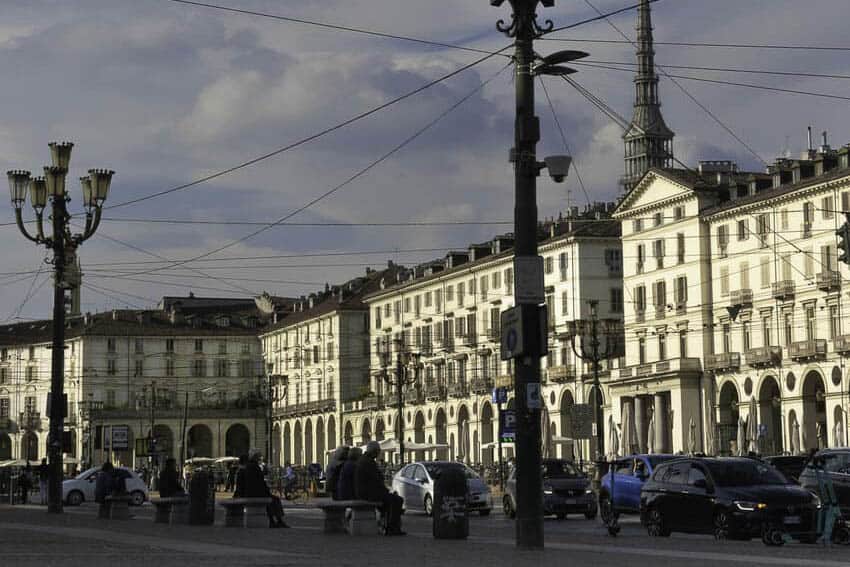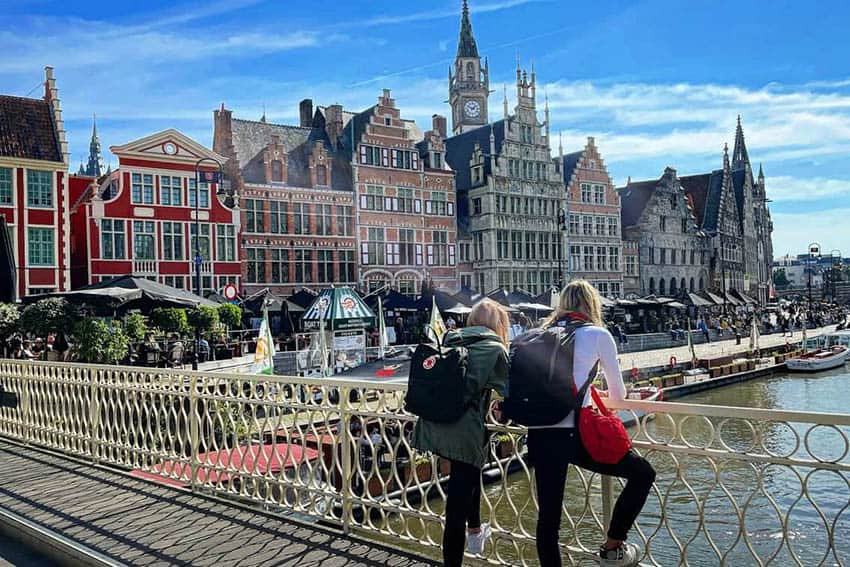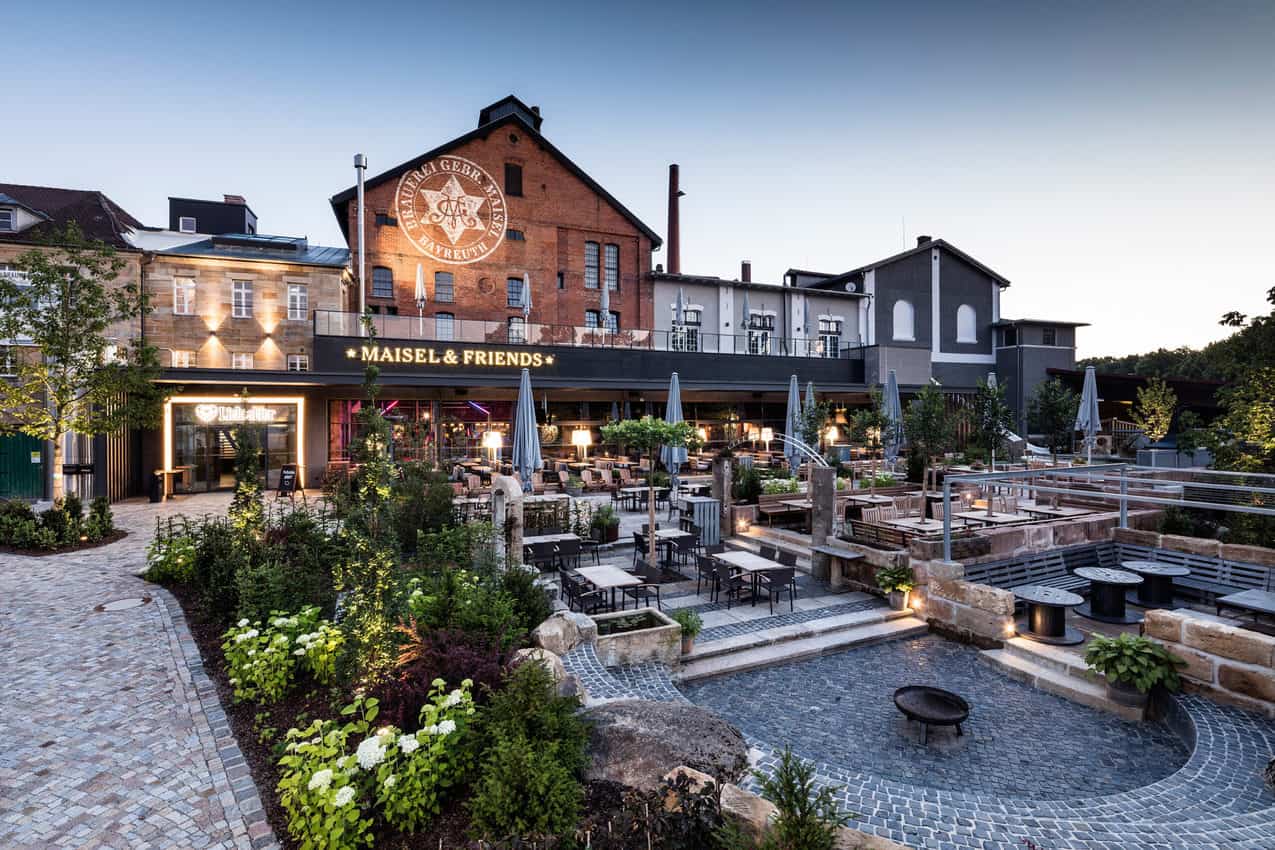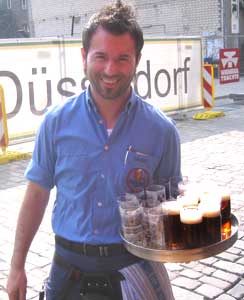
By Larry Parnass
It is a Thursday night in theold cityy section of Düsseldorf, Germany. Inside the busy Zum Schlüssel brewery, arriving guests pour themselves into nooks, their jackets dappled with raindrops.
One group of two dozen, unaware of their odds in this clubby, noisy place, funnels into an alcove to wait. At least they’re inside one of this city’s premier breweries, they must be thinking, out of the rain and just minutes from platters of leberwurst or Schweinshaxe, mounds of whole wheat rolls and glasses of the hoppy, copper-colored beer being pulled from a wooden keg.
About the time they should be ordering, a waiter in a linen apron presses his way in among the standing guests carrying a tray wedged with narrow, quarter-liter glasses of alt — the fresh beer “old” by name only.
In seconds, the glasses are distributed. Voices bubble up with toasts. Then, in minutes, the would-be diners are filing out into the night, which begs the question: What kind of tavern can send so many people away supperless with such a good feeling?
Yesterday’s Tastes
It is a place they aren’t making anymore. The Zum Schlüssel is one of the few old-school breweries in the neighborhood that hugs the Rhine at the center of this bustling regional capital. Even the brewery’s motto seems chiseled by experience: “Eat what’s cooked, drink what’s clear, speak what’s true.”
Around this brewery and its equally storied brethren, streets are filing up with trendy businesses that cater to shopping habits visitors bring with them. A truly memorable latte at the Düsseldorf Starbucks about to open around the corner? I don’t think so.

Tapping a barrel at Uerige
But the Zum Schlüssel — and the Füchshen Brauerei and Heidelberger Fass, better known as Uerige — serve up something unique. They offer a bridge to another time, and another time’s tastes.
And isn’t this why we travel?
On that Thursday night, it was good enough reason for my 13-year-old daughter Libby and me to step into the Zum Schlüssel. The people streaming in looked like they were fleeing a blizzard. They had found the coziest place on earth.
Sacrament of Alt
You can find great beer throughout Europe, including in nearby Belgium. Düsseldorf’s public houses offer something more than that tawny river of beer. It is an unadulterated, home-grown culture with roots in the 16th century. It is a pride of place. Here, a home-made beverage is not a commodity, it’s a sacrament.
Duesseldorf is a city, after all, with bronze replicas of clamped beer bottles in its official monument.
In the breweries, the kobes — the term used for waiters — are unashamedly self-righteous about their white-capped wares. They bring that second and third foaming glass without asking.
And there is no fuss over what to drink. Patrons make their selections when they walk into these old public houses.
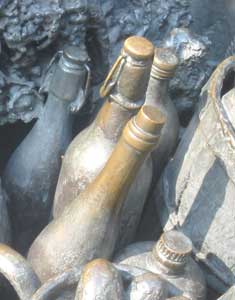
There is something unifying, and blessedly simple, about people drinking the same beer in a tavern. Maybe it is a freedom from choosing. It also makes the math pretty straightforward. After delivering a beer, the brewhouse staffer adds a hash mark to the beer mat’s running tally.
Every night, in every brewhouse in the old city, battalions of short, copper soldiers are dispatched from the bar.
“If you come to Düsseldorf, you have to drink alt beer,” says Holger van den Boogaard, who had stopped in at the schnapps bar Kreuzherreneck for several Frankenheim alts. We found him there and got to talking. “After three, four or five, it tastes like the best beer in the world.”
Van den Boogaard intends that as a compliment. Even after five beers, he means, the crispness of the alt can still be savored. “For everyone who’s born here, it’s very important,” he says of alt beer. “It’s maybe the most important.”
Served in glasses capped by an inch of foam, an alt beer has a way of going down easily. On the day we visited Kreuzherreneck, an old and easy-to-miss bar also called Bobby’s, the bartender offered a confession, as he tended a few other customers (adding a requested dash of Coca-Cola to one patron’s alt) and helped a band, the Blues Missiles, set up in the cramped space.
“Once I drank 40 in 12 hours,” the barkeep said. (Not surprisingly, there was a nap in the middle of that embrace of alt.)
“It’s healthy,” van den Boogaard says, after weighing his bartender’s admission. “No chemicals. Most time, you have no hangover.”
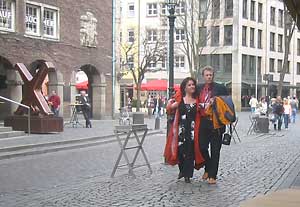
Follow the Crowds
Alt beer doesn’t travel well, so we go to it.
The call of Düsseldorf alt is heard all around the region, by autoworkers and accountants alike, drawing weekend crowds.
Düsseldorf’s Altstadt is their target: an 25-block area of three- and four-story buildings salvaged or rebuilt after Allied bombing during World War II. It is a sturdy district of brick and stone buildings with handsome facades. Centuries ago, it was gated and walled. The streets branch out from the Burgplatz, a large open square on the river.
Once, dozens of breweries filled the neighborhood with the smell of hops, barley and malt. Over the decades, most of them closed or consolidated and moved out to modern industrial parks. Some of the old brewhouses closed as long ago as World War I, when their copper kettles were melted down and reused, and beer-making ingredients were in short supply.
The survivors like the Zum Schlüssel now rule the old town’s alt-beer culture. They are tucked into side streets and aren’t easy to find — unless you study the crowds and follow along.

The whole district pulses with activity, particularly since 1995, after the city relocated a riverside highway to create a long promenade on the east bank of the Rhine.
Out on the wide river, barges ferry coal and products to market.
Ashore, the byways are just as busy; the area is home to dozens of restaurants, many offering foreign cuisine. Spanish and Argentine eateries abound.
At a streetside cafe called Marrakesh, hipsters sit smoking cigarettes and watching passersby.
Party Central
The stone surfaces of the Altstadt are party-ready: Starting Thursday nights, it summons knots of young men and women and couples of all ages.
Some Düsseldorfers say they steer clear of the area on the busiest nights, to avoid the rowdies. Police have been stepping up patrols and mounting video cameras to keep track of trouble.

Early on the Saturday evening we were in the old town, we passed a group of six young men who already seemed well lubricated. All carried large, open bottles of beer. Two had teamed up to transport still more beer, loaded into a large plastic crate pulling mightily on their arms. Everywhere, bottle caps have been trampled into the street.
Another movable beer party — and small business — plies the streets on wheels. On the “party bike,” customers aboard what looks like a tricked out hot-dog cart drink while pedaling, propelling their way
through the old town.
But in our three-day visit to Düsseldorf, we mostly found a down-to-earth city whose warm, pragmatic atmosphere is set by its residents, not its visitors. Alt beer is unmistakably part of it. In place after place, beer and the food fuel an intense sociability.
Reach for Purity
Renate Morton, a guide for the city’s tourism bureau, took Libby and me for a walk around the district late one morning. She explained that Düsseldorf’s hold on brewing history goes back to 1516, when an alimentary law set rules still observed by brewers.

Only four ingredients were allowed under this dictum: water, malted barley or wheat, yeast and hops. In 1712, another decree separated the crafts of baking and beer-making, to guarantee the best products from both trades.
The brewers top-ferment their beer, the legacy of a time when, lacking refrigeration, they had no choice but to let the yeasts rise to the top of vats. The style still defines Düsseldorf’s contribution to beer-making, even in an era of global trade.
“Everybody knows that alt beer cannot be transported,” says Morton. “It turns.”
Though most beer-making takes place outside the old city, the remaining breweries are like cardinal points in the old town, keeping history current.
We walked into Uerige, one of the most popular brewhouses, around lunchtime and found a table back by the entrance to the interior brewery. The smell of yeast hung in the air. Customers were downing glasses of beer with their wursts.
The need for places to seat customers has led brewery owners to carve out rooms of all shapes and sizes in the cramped buildings they occupy.
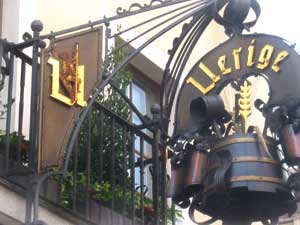
At Uerige, for instance, a front door brings you in off the street past a narrow room on the right stuffed with tables. Down the hall, rooms jut out on the left and some tables cling to wall space along the passageway. Each of the rooms has its own name, including “the Sauna.”
In the rear by the brewery, a high-ceilinged room balloons out to welcome guests. And through yet another door, chairs and tables share a room where the kegs are tapped.
Stick to the Alt
It seems unnecessary, but a playful sign posted by the landlord admonishes customers to stick to the alt. “No drinking schnapps in here while consuming beer. It damages your health and my business.”
Outside Uerige, sidewalks on both sides of a street have been annexed. Their tables fill with hundreds of customers on weekend nights — people stopping in for a quick beer or a long talk.
As she spoke of Uerige’s history, Morton sipped politely at her alt, but left half of it behind. I drank mine down and made some notes about its flavor: a little floral, with a lingering taste of hops.
Anyone visiting Düsseldorf to savor the old-style beer culture must also stop in at:

— The Zum Schlüssel at Andreastrasse 43-47. Before that group of two dozen came in out of the rain, we’d found a little table in view of the tapping area. There, the staffer known as a Zappes was drawing glasses of beer from a wooden keg canted up on a piece of lumber, then sliding them theatrically down a long bar covered in perforated copper.
Though the glasses seemed all foam when they started the trip, by the time the Kobes collected them onto trays, the beer level was two-thirds up the glass and ready to please.
In a nearby room, six women sharing a table were laughing riotously and toasting each other.
I ordered a plate of black pudding with onions and got the blast of flavor it promised. A stream of Kobes passes bearing trays of beer, cheese and shiny brown rolls.
The business is owned by the Gatzweiler family, which claims membership in the Brewers’ Guild since 1313. The family also makes “Gatz,” an alt beer, at an industrial plant outside of the old town. At the Zum Schlüssel, however, only the alt brewed on the premises is sold.
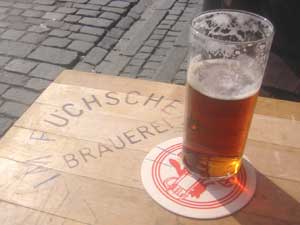
A table at the Füchshen Brauerei
— The Füchshen Brauerei at Ratingerstrasse 28. This small but major-league house brewery was founded in 1848 and sits on the oldest main street in Düsseldorf. The building, which dates to at least 1640, once housed a public school. Its alt beer is bright, tangy and medium-bodied. Outdoor tables that catch late-afternoon sun are usually filled. The brewery’s name means “little fox.”
— Frankenheim Brauerei on Wielandstrasse 14-16. While not in the old town, this enormous and inviting tavern is a short tram ride east. The brewery itself long ago moved to the scheel sitt, or “ugly side” of the Rhine. Frankenheim alt is creamy, with less of a hoppy aftertaste than others and a little sweeter.
The menu offers all the hearty specialties of this cuisine, like salted knuckle of pork and sauerbraten, as well as a deer goulash and roast stag. My daughter had a delicious potato soup with croutons and I tackled the”Duesseldorf mixed sausage platter,” which included twin mounds of sauerkraut and mashed potatoes.
It was our last dinner in Düsseldorf and was, in every way, a stick-to-the-ribs treat. That second alt beer to wash it all down? No, I didn’t have to ask.

Other Sights, Activities
— When not admiring the bouquet of alt beers, my companion and I bicycled the city, taking advantage of its many bike lanes and parks. A good place to rent bikes is the outfit called Rad ab, at Friedrichstrasse 112.
— One of our favorite destinations in the city was the Tanzhaus art and performance center, where we caught a tremendous flamenco ensemble, “Flamenco en Route.”
— We also enjoyed the aquarium, which sits on beautiful grounds just north of the city center and is home to a collection of specialty gardens.
— In the old town, we spent an hour inside the Exhortation and Memorial Site, which, in exhibits and its own presence, tells the story of the persecution and murder of Jews in Düsseldorf during the Nazi era. You can visit former interrogation rooms in the cellar of the structure at Muhlenstrasse 29.
— We took in the retrospective exhibit on Picasso’s late works (no longer on view, sadly) at the K20 Kunstsammlung NRW, the city’s pre-eminent modern art museum. Now is the last time to visit for a while. After Oct. 29, 2007, the museum closes for renovations until 2009.
— The city’s modern shopping district — with its perfumed malls and its equivalent of Fifth Avenue — is centered around the lovely boulevard called Konigsallee, a few blocks to the east of the old town.
Lodging
For the four nights we prowled Düsseldorf, our home was the Hotel Terminus. The hotel, at Am Wehrbahn 81-81, is a superb alternative to trendier (and costlier) lodging. The Hotel Terminus is small, quiet and family-run.
The staff at the front desk helped resolve many of our questions, hopping on the Internet to secure reservations and information without hesitation. It is located in the Schadowstrasse shopping area — and virtually across the street from one of the best old-style German taverns, the Frankenheim Brauerei at Wielandstrasse 14-16.
While the street face of the hotel is unremarkable, its 23 rooms have been updated and are spacious and comfortable. There is a small pool on a lower level, with a nearby sauna. The pool is too small for laps, but is a pleasant place adorned with large wall mosaic of Greek bathers.
The hotel offers a large breakfast buffet that is included in the room price. Daily rates for doubles are about 138 Euros, with the cost dropping to around 88 Euros on weekends.
The hotel provides cards for free public transportation in Düsseldorf. The old town is a five-minute tram ride away.
 Larry Parnass is the former managing editor of the Daily Hampshire Gazette in Northampton, Massachusetts.
Larry Parnass is the former managing editor of the Daily Hampshire Gazette in Northampton, Massachusetts.
- These 9 U.S. National Parks Require Reservations in 2024 - April 17, 2024
- Take a Hike in Olympic National Park - April 17, 2024
- The Wild Mississippi: 2340 Miles Across Ten States - April 8, 2024


